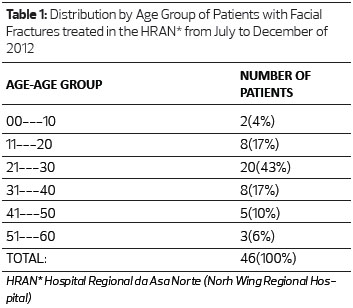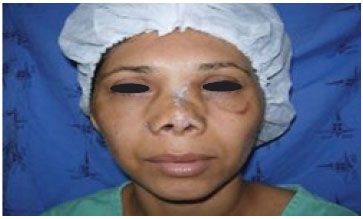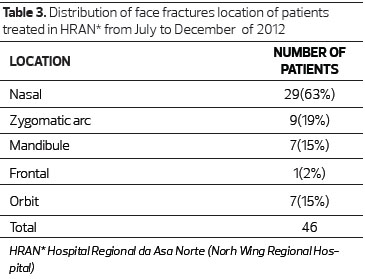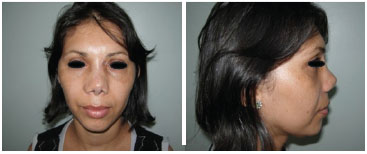ABSTRACT
INTRODUCTION: Trauma remains a major cause of morbidity and mortality amongst young adults in the Western world. The prevalence of traumatic lesions on the face is especially high, as the facial area is generally exposed with little protection.
OBJECTIVE: To evaluate the etiology, age, sex, location, symptoms, and the type of treatment given to victims of facial trauma treated at the North Wing Regional Hospital (NWRH), Brasilia, Federal District.
METHOD: This was a retrospective study conducted in the emergency room of the NWRH to evaluate the epidemiological profile of patients with facial trauma who presented during the 2nd half of 2012.
RESULTS: The study included 46 patients, of which 32 patients (69.56%) were male. Physical aggression was the prevailing cause in both sexes with 22 cases (47.82%), followed by falls with 11 (23.91%). Falls were the predominant cause of injuries in children. Physical aggression as a mechanism for facial trauma became more common with age. The main age group affected was the 21 to 30 years group, comprising 43.47% of cases. The nose was the most commonly affected bone in facial fractures, with nasal fractures occurring in 62.96% of cases. The mean hospital stay was two days and the mean time between the first visit and the operation was six days.
CONCLUSION: The predominant epidemiological profile of a patient with facial fracture is that of a young male, victim of physical aggression, presenting with a nasal fracture and a clinical picture of this type of injury, and treated with closed reduction.
Keywords:
Plastic Surgery; Facial Injuries; Physical Aggression.
RESUMO
INTRODUÇÃO: O trauma permanece como uma das principais causas de morbidade e mortalidade, no mundo ocidental, entre os adultos jovens. A prevalência de lesões traumáticas na face é alta devido à enorme exposição dessa região e a sua pouca proteção.
OBJETIVO: Avaliar a etiologia, a idade, o gênero, a localização, os sintomas e o tipo de tratamento das vítimas de traumas de face dos atendidos no Hospital Regional da Asa Norte (HRAN), Brasília, Distrito Federal.
MÉTODO: Trata-se de um estudo retrospectivo, realizado no pronto socorro do HRAN-DF, visando avaliar o perfil epidemiológico de vítimas de trauma de face, no período do 2º semestre de 2012.
RESULTADOS: O estudo compreendeu 46 pacientes, destacando-se o gênero masculino, com 32 pacientes (69,56%). Quanto à causa, predominou a agressão física, em ambos os sexos, com 22 casos (47,82%), seguida pelas quedas, com 11(23,91%). As quedas foram as causas predominantes das lesões em crianças, mas se verificou a participação cada vez maior da agressão física como mecanismo de trauma facial com o aumento da idade. A principal faixa etária foi de 21 a 30 anos, compreendendo 43,47% dos casos. O nariz foi o local mais acometido nas fraturas de face, correspondendo a 62,96% dos casos. O tempo médio de internação foi de dois dias e o tempo entre o primeiro atendimento e a operação foi de seis dias.
CONCLUSÃO: O perfil epidemiológico do paciente com fratura de face é de um jovem, do gênero masculino, vítima de agressão física, com fratura de nariz e quadro clínico desse tipo de lesão e submetido a redução fechada.
Palavras-chave:
Cirurgia Plástica; Traumatismos Faciais; Agressão Física.














